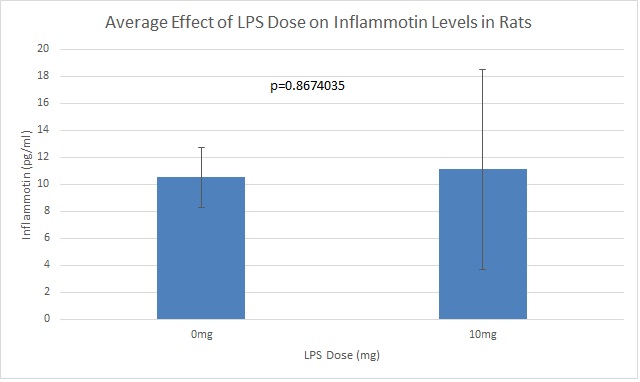BME100 f2013:W900 Group8 L2
| Home People Lab Write-Up 1 | Lab Write-Up 2 | Lab Write-Up 3 Lab Write-Up 4 | Lab Write-Up 5 | Lab Write-Up 6 Course Logistics For Instructors Photos Wiki Editing Help | |||||||
|
OUR TEAM
LAB 2 WRITE-UPDescriptive StatisticsExperiment 1: Humans
ResultsExperiment 1: Humans
Experiment 2: Rats
AnalysisExperiment 1: Humans As the graph of the ANOVA test shows, the p-value obtained is extremely small. This means in respect to the dosages that there is a substantial difference between each dosage given to humans and the inflammotin response each dosage creates.
Based on the p-value obtained by the t-test in the rats, 0.8674035, it can be determined that there is no statistical difference between the two dosages given.
Summary/DiscussionWith the given data, many conclusions can be made. Through statistical analysis, information finding averages, standard deviations, standard errors, and p-values were found. These values were found for both human and rat samples. Regarding the human samples, it can be inferred through the t-test that each added dosage had a significant addition from the previous dosage. This is also shown through the extremely small p value, which shows the substantial difference between dosage and inflammotin levels. The t-test for the human and rat samples were unpaired due to the different human and rat samples participating in the experiment. This variance shows the universal effect LPS dosage has on humans and rats instead of one specific sample in regards to inflammotin levels. According to the p-value produced from t-tests run on the Human data, p-values show that there were statistically significant differences between each dosage group. Considering the p-value when comparing a 0 mg dose to the 5 mg dose, the 5 mg dose induces a statistically significant inflammotin response compared to placebo. This shows that the smallest dosage required to induce a significant inflammotin response compare to baseline inflammotin levels in the body is 5 mg. As the dosage is increased, inflammotin response increases significantly. When considering the rat models, there was no significant inflammotin response between the 0 mg dose and 10 mg does. One could conclude from this study that rats do not respond to LPS, but because of the small sample size and small range of doses, more studies may need to be done to reach a more solid conclusion.
| |||||||






